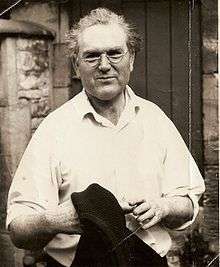John Bridgeman (sculptor)
| John Bridgeman | |
|---|---|
 John Bridgeman outside his studio | |
| Born | 2 February 1916 |
| Died | 29 December 2004 (aged 88) |
| Notable work | Mater Dolorosa, Coventry Cathedral; Compassion for Dudley Road Hospital, Birmingham |
Arthur John Bridgeman ARCA, FRBS, FRBSA (2 February 1916 – 29 December 2004) was an English sculptor.
Life
Born in Felixstowe, Suffolk and named Arthur John, he was usually called 'Bridge' by his friends and signed himself John Bridgeman. He entered Colchester School of Art at the age of 14, and went on from there to the Royal College of Art, where he studied with Frank Dobson.[1] His first love was painting, and it was during this period that he produced many gouache paintings and pastels in a Romantic style celebrating the English countryside.[2]
His RCA studies were interrupted by the Second World War, during which he registered as a conscientious objector, and worked on rescuing people in Fulham bombed during The Blitz; this had a profound effect on him, influencing his art throughout the rest of his life. After the war he was awarded the British Prix de Rome, but did not take up the scholarship, instead going on to work with Misha Black and then on the Dome of Discovery for the Festival of Britain. After a spell as head of sculpture at Carlisle School of Art, 1951–56, he succeeded William Bloye as head of Sculpture at Birmingham School of Art where he worked until retirement in 1981.
Sculpture
His work was popular with both private and municipal patrons and he contributed particularly to the regeneration of Birmingham after the war through the creation of a number of iconic pieces of public art. He also created play sculptures for children in the new council estates which were being built - an innovative idea that was ahead of its time in the 1950s.[3] The last known surviving example was grade II listed in 2015.[4] Always experimenting with new materials, his cement fondue Mother and Baby for Birmingham Maternity Hospital (now Birmingham Hospital for Women) [5] and the over-life-size bronze group Compassion for Dudley Road Hospital (now City Hospital) re-sited on an internal wall in 2004 after having originally been placed on the outside of the building.[6] are typical of his large scale commissions. The Mater Dolorosa in the Lady chapel of the then recently rebuilt Coventry Cathedral is perhaps the most powerful of his religious works, which he created throughout his life.[7] His philosophy of art and his interest in methods and materials are embodied in the book he co-wrote with his wife, the author and journalist Irene Dancyger, Clay Models and Stone Carving, 1974. Towards the end of his life he concentrated on smaller female figures proving himself to be one of the last great practitioners of the art of lost-wax modelling.
Gallery
- John Bridgeman Mother and Child City Hospital, Birmingham
.jpg)
Bibliography
- Dancyger, Irene, Clay Models and Stone Carving, London, 1974 ISBN 0-87749-564-5
- Noszlopy, George and Beach, Jeremy, Public Sculpture of Birmingham, Liverpool, 1998, p. 56 ISBN 0-85323-692-5
- Fieldhouse, Ken and Woudstra, Jan, The Regeneration of Public Parks, London, 2000, p. 162 ISBN 0-419-25900-7
- Noszlopy, George, Public Sculpture of Warwickshire, Coventry and Solihull, Liverpool, 2003, p. 171 ISBN 0-85323-837-5
- Noszlopy, George and Waterhouse, Fiona, Public Sculpture of Staffordshire and the Black Country, Liverpool, 2005, p. 170, ISBN 0-85323-989-4
- John Bridgeman: Landscape to Sculpture, Exhibition held at the Leamington Spa Museum and Art Gallery, 25 January - 21 April 2013, ISBN 978-1872940007
Notes
- ↑ Study of a Female Nude by FRANK DOBSON
- ↑ Modern British art does have its quiet side
- ↑ Play Sculpture
- ↑ Historic England. "Details from listed building database (1423375)". National Heritage List for England. Retrieved 17 June 2015.
- ↑ Mother and Child
- ↑ Compassion
- ↑ Mater Dolorosa
- ↑ "Sixties playground sculpture in Birmingham is Grade II listed". BBC Online. 12 February 2015. Retrieved 15 February 2015.
External links
| Wikimedia Commons has media related to John Bridgeman. |
- Obituary of John Bridgeman from the Independent 13 January 2005
- Public Monument and Sculpture Association National Recording Project
- Family Group, St Bartholomew's, East Ham
- Gallery Pangolin
- Coventry Cathedral Appeal: Seeking Sanctuary Refugee Monument
- Landscape to Sculpture Exhibition at Leamington Spa Gallery and Museum 2013
- Henry Moore Institute Archive